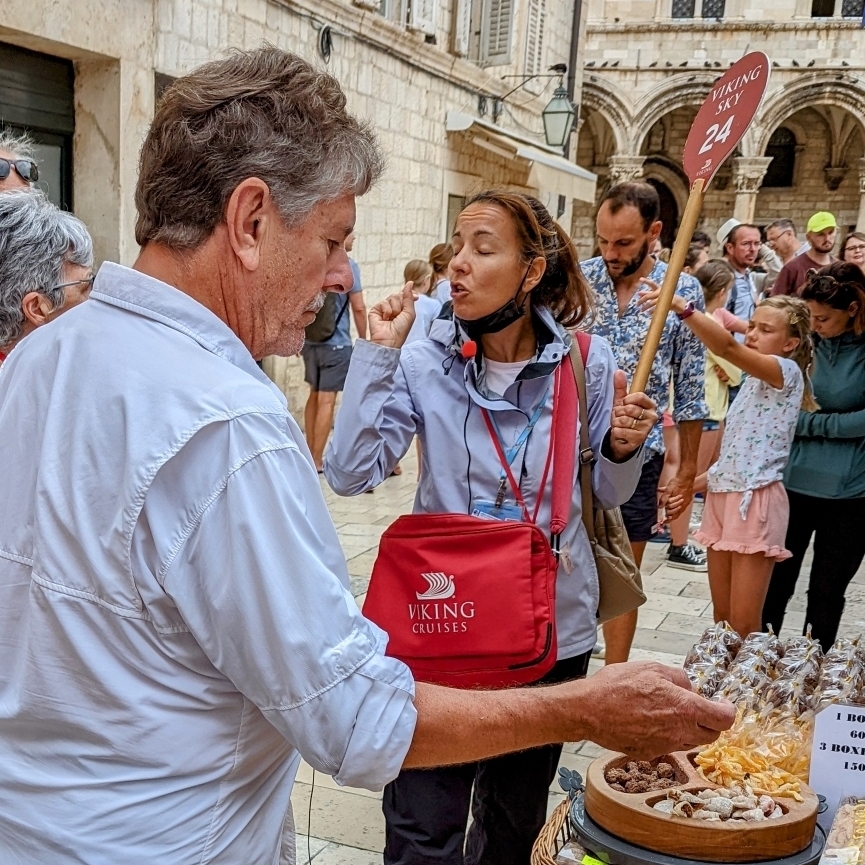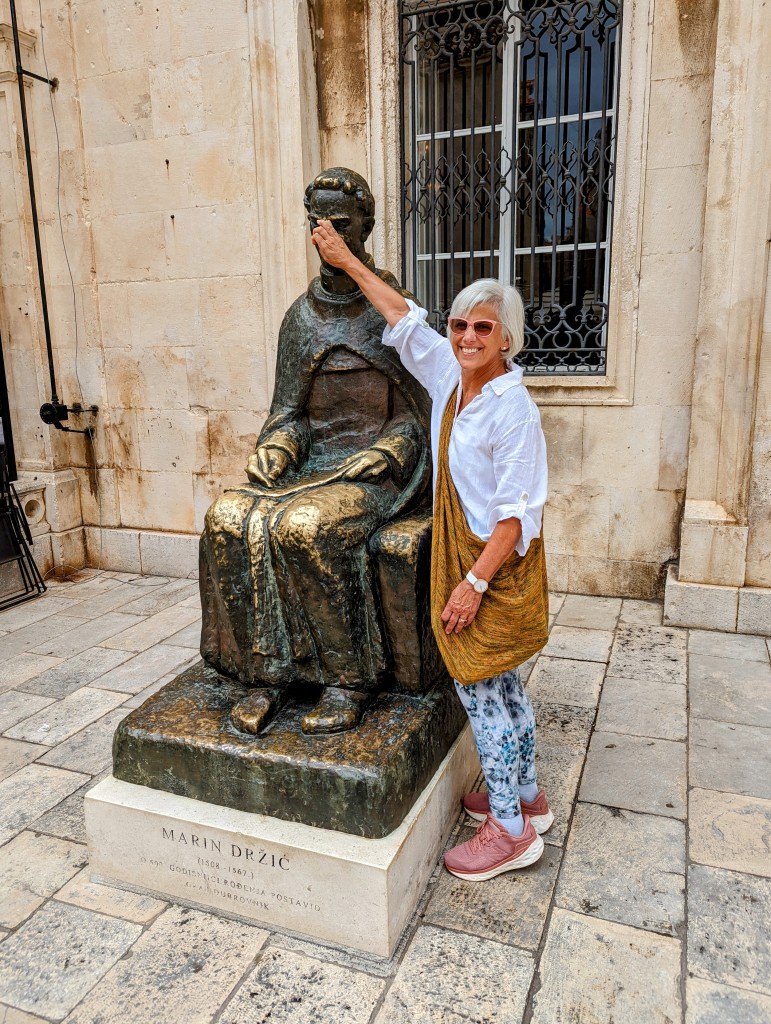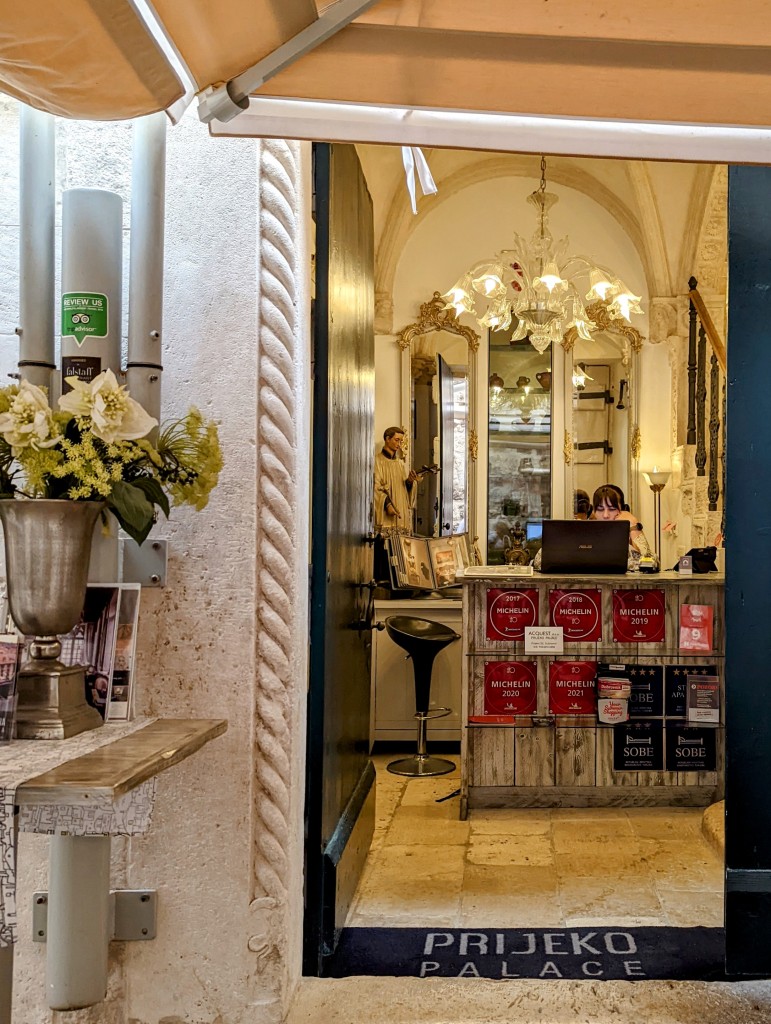
Dubrovnik is our third and last city to visit on Croatia’s Dalmatian Coast. While playwright George Bernard Shaw might have called Dubrovnik “paradise on earth,” we found it overwhelmingly congested and not nearly as inviting as our first two Croatian ports Sibenik and Split. Perhaps it’s the pent-up demand for post-covid travel that makes it seem as though everyone has come to Dubrovnik, and if that’s the case, it sure beats the alternative!
Our first stop was to view Fort Lovrjenac or St. Lawrence Fortress. Built around 1018, it is an impressive stone fort just outside the city walls. Its usefulness as a fortress has diminished over the years, and today it stands as a theater, museum, and a popular wedding venue.

A short distance away is the Pile Gate to the Old Town. We were struck by how well the Medieval walls have been preserved. Although walking the walls is one of Dubeovnik’s most popular tourist attractions, we were discouraged by the long, crowded lines. Instead, we opted to take a leisurely walk around the fortified city, admiring its blend of Gothic, Renaissance, and Baroque architecture.

Immediately upon entering, we were greeted by a very tall friendly fellow offering “Hearts for Happiness” for 1€ apiece…a small price to pay for happiness!

A few steps away are St. Saviour Church and Big Onofrio’s Fountain. We learned that all of Dubeovnik’s fountains offer clean filtered water that’s safe to drink. People can be seen filling water bottles at one of 16 sides of the fountain.


Just around the corner we approached a monk feeding the pigeons. Apparently it’s not a crime in Dubrovnik as it was in Venice!




Further along is Orlando’s Column, a well-known monument in the heart of Old Town. Built in 1418 and currently undergoing significant restoration, Orlando is an armoured knight. According to legend, Orlando helped the Ragusa (people of old Dubrovnik) defend themselves from invaders in the Middle Ages. Although I couldn’t get a full photo due to extensive scaffolding, the first step at Orlando’s base holds special significance. Before more standard measurements were developed, merchants used the length of the step as a common way to measure items for sale.

Next stop is Luza Square, site of the Old Town’s clock tower. Originally built in 1506, the tower has been destroyed and re-built several times. Only the antique bell remains from the original tower. When the octopus hands reach the hour, the zelenci (green) twins Maro and Baro strike the bell.
Saint Blaise Church, in honor of Dubrovnik’s patron Saint Blaise also occupies Luza Square. Every year on February 3, the Feast of Saint Blaise is celebrated with Mass, a procession, and blessing of throats. The regional holiday City of Dubrovnik Day is also celebrated on this day.


The fresh market offers fresh fruits, vegetables, local delicacies, and other local products such as soaps, lotions, and herbs.





A large bronze statue of Croatian Renaissance playwright Martin Drzic, affectionately called “Dubrovnik’s Shakespeare,” sits next to Domino Church. His shiny bright nose is the result of a tradition of rubbing it for good luck.


And Croatian hospitality is legendary. Warm, inviting shops and restaurants offering traditional dishes, wines, and other local products line the narrow streets and broad piazzas, welcoming locals and visitors to enjoy a meal, a snack, and other refreshments. The open doors provide a glimpse of the delights that await within.






Dubrovnik has definitely come into its own as a popular tourist destination. Its well-preserved traditions and historic sites lure thousands of tourists from March through September. We were there at the height of the tourist season. We would love to return in the fall in order to be able to experience this city more fully.
When we visited in 2013 we stayed in the old city for 3 nights. We had plenty of time to walk the walls and enjoy this old city. One day we spent touring around outside the walls and when we came back we were confronted with thousands of cruisers coming and going through the gate. We were glad it wasn’t and everyday event during our stay! Another little tidbit about Croatia is that they claim to be the originators of the necktie!
LikeLiked by 1 person
The cost to walk the walls is now 33€ per ticket…not sure what it was when you were there, but it doesn’t seem to be a deterrent. And why would anyone take “credit” for the tie… should be “blame” 🤣. Thanks for the info!
LikeLike
Wow! No cost in 2013 to walk the walls! And, since I was still wearing ties in those days I paid a princely sum for a 1 of 2 design at the “origin” shop! 😎
LikeLiked by 1 person
The fort looks like the setting for the Nobel,”The Guest Book.”
LikeLiked by 1 person